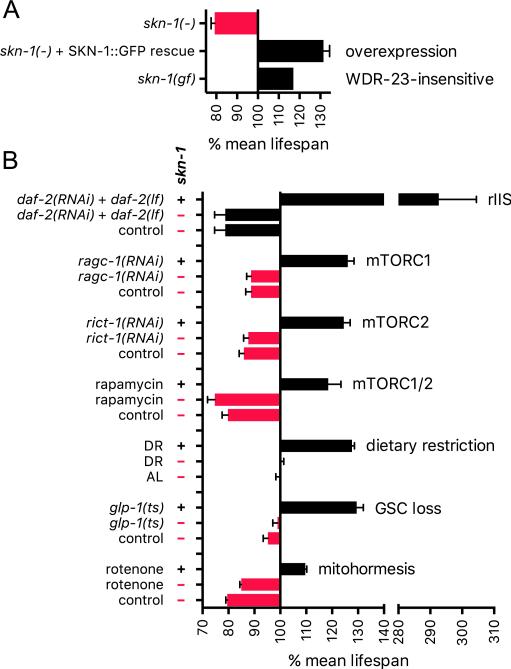Fig. 6.
SKN-1 and longevity. (A) SKN-1 promotes longevity in otherwise WT animals. Lifespan was extended when an skn-1 mutant was rescued through overexpression from a transgene that encodes SKN-1b and SKN-1c in which the GSK-3 site (Fig. 5B) is mutated, resulting in constitutively nuclear localization in the intestine [20]. Smaller effects were observed in the WT background. Lifespan was also increased by an skn-1 gain-of-function mutation that disrupts inhibition by WDR-23 [17]. Relative median lifespan is graphed for this experiment, with means shown for all others. (B) skn-1-dependent longevity interventions. The reduced IIS (rIIS) experiment shown was performed at 15 °C [43]. skn-1 was also required for lifespan extension by daf-2 RNAi alone at 15 °C, 20 °C, and 25 °C. In each case of skn-1-dependent rIIS lifespan extension, dauer-related processes appeared to be inactive in adults [43]. Analyses of ragc-1, rict-1, and rapamycin are described in [29]. RAGC-1 is needed to transduce amino acid signals to mTORC1. DR results shown are from [19]. skn-1 was also largely required for lifespan extension in a different liquid DR protocol that gave greater lifespan extension [127]. AL refers to ad libitum feeding. For unknown reasons, skn-1 mutation does not reduce lifespan under AL conditions in these liquid culture protocols. Germline stem cell (GSC) loss increases lifespan in an skn-1-dependent manner [30]. Mitohormesis refers to stress resistance and longevity that arise from mitochondrial ROS production, here induced by rotenone treatment [128].

